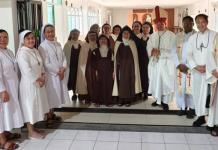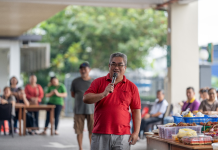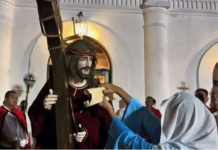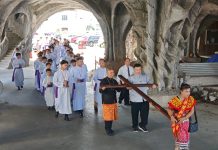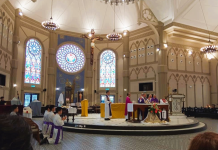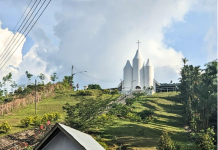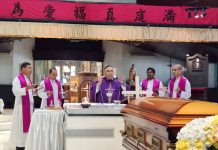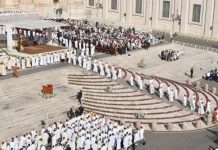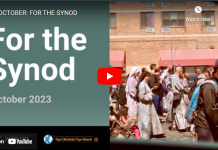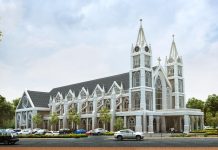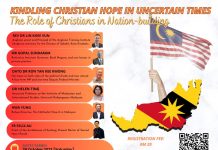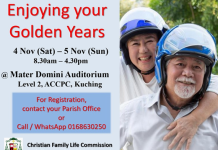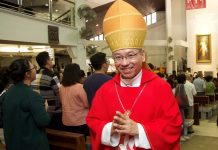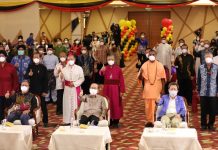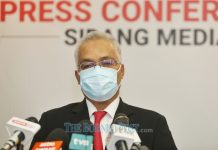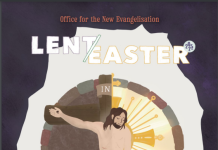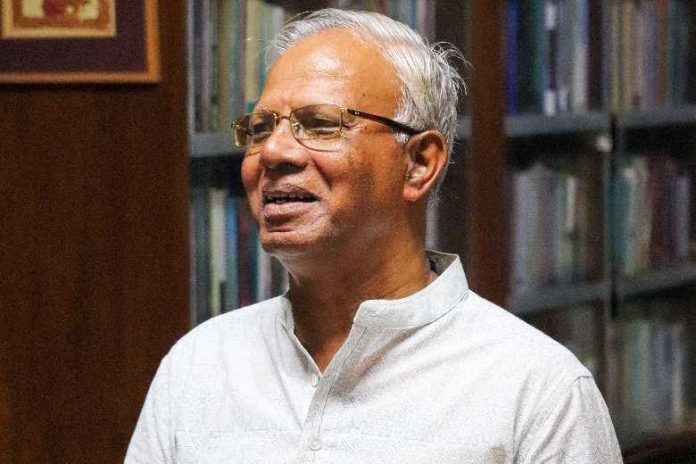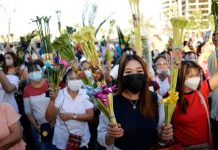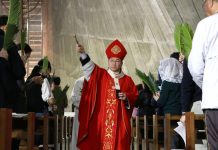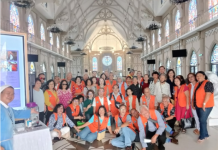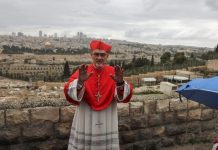Interview with Father Felix Wilfred
By Rock Ronald Rozario
In the following two-part interview, Indian theologian Father Felix Wilfred explains the serious structural changes that should be In this second part of a two-part interview, Indian theologian Father Felix Wilfred speaks about the problems challenging the Asian Church, its leadership, Asian theology and the Asian bishops’ federation. In the first part, Father Wilfred, a former secretary of the theological advisory committee of the Federation of Asian Bishops’ Conferences (FABC), suggested serious structural changes to make the Church truly owned by the “people of God.” The 74-year-old theologian advocates that the Church become an inverted pyramid with laity actively involved in its decision-making process.
Part 2
You were part of innovative theological ideas like “new evangelization” and “new way of being Church” in Asia in the 1980s. How successfully have these ideas been implemented? What are their impacts on the Church in Asia today?
The documents produced by the Federation of Asian Bishops’ Conferences (FABC) in the 1980s and 1990s are of different quality and have a lot of openness. For example, the very first document the theological advisory committee brought out was on interreligious dialogue, followed by the one on local churches. These are watershed documents and points of reference.
What has happened since then? The FABC was in the forefront, and scholars were quoting it, and it generated such enthusiasm globally. In 1990, the Bandung Conference, where I had the privilege to deliver the keynote address, became a turning point. There was a feeling of fear about the FABC’s theological orientation. I can say that as an eyewitness. A kind of conflict was experienced there.
Cardinal Josef Tomko, the prefect of the Vatican’s Congregation for the Evangelization of Peoples, was present. He had earlier stated that India was the epicenter of theological confusions in Asia. There was an unusual presence of Vatican Curial officials and several nuncios from Asian countries. Generally, it was not like that and usually one or two used to be invited there. So, this large concentration of representatives from the central administration of the Church showed a sense of unease about what was happening in the Church in Asia or the FABC. This is one reason why the problems started. The people got a little frightened. Asians have a colonial heritage and they love to follow the line of their masters.
The other reason is the poor quality of church leadership in most parts of Asia. Barring a few exceptions, by and large, the quality of leadership went down and has now become bland and uninspiring. The criteria for the selection of bishops have changed considerably. During the period immediately after Vatican II, bishops were selected based on their ability to carry out the decisions and teachings of the council. Their openness to the world and their pastoral aptitude also were considered.
Now, the criteria have changed, and the basic question seems to be the loyalty of the prospective bishops. What are his views on sexual morality, reproductive issues or communism? The primary concern was not pastoral quality but hierarchical loyalty. So, unfortunately, the last two pontificates produced bishops in this way. So, most of the current Asian Church leaders don’t represent the needs of their people and it is not what is required to face the political situations in various Asian nations.
Now, there is another reason: a deliberate attempt to control Asian theologians and theological thinking. For example, the excommunication of Father Tissa Balasuriya of Sri Lanka showed the extent of concern and visceral fear about what is happening in Asia, especially from the Vatican’s Congregation for the Doctrine of Faith. In hindsight it looks like shadow boxing.
I am reminded of American psychologist Abraham Maslow, who said that “when all you have is a hammer, everything looks like a nail.” This is a metaphor. The Congregation of the Doctrine of Faith could only see nails in Asia that needed to be hammered instead of promoting local churches, which is the goal of Curial offices. It had a demoralizing effect on Asian churches. And then you have the leaders who are chosen on the basis of loyalty.
How do you see the FABC now, particularly under current president Cardinal Charles Bo of Myanmar? Is there any hope of regaining its past prominence?
I am not very much in touch with the various offices of the FABC right now. But I had exchanges with Cardinal Bo and told him that we should make the FABC fully alive and understood. We had frequent exchanges until the problems of militarization in Myanmar in February 2021. He was enthusiastic. He issued some strong and timely statements reacting to political events in Asia. Yes, a revitalization of the FABC is needed. Once the FABC offices were headed by Western missioners in Asia and the idea was they would bring money. Now, Asians are more capable of bringing money.
There should be somebody in the office who knows Asia and its Church. Father Edward Malone, a Maryknoll missionary, was there as an assistant secretary-general for 32 years. He did a good job, no doubt about it. But his works were not followed through. I don’t see anything extraordinary in the present FABC despite it having a vibrant and deeply spiritual president in Cardinal Bo, who can feel in his heart the pain of the poor. Unfortunately, the political situation in his country and the preoccupations there prevent him from giving the FABC the kind of leadership he would like to give.
The way minority Christians in Asia live their faith in multireligious and multicultural societies is unique and unparalleled. Why are Asian theologians unable to interpret and share this refreshing experience of faith with the universal Church?
I believe Asia has much to offer the universal Church. Many of the innovative theological thoughts and perspectives, especially issues concerning religions and interreligious dialogue, originated in Asia, and they have become part of mainstream theological talks today. We now realize that it is not sufficient. What we have been saying about the presence of the spirit in other faiths are the voices of Asians. But unfortunately, these thoughts have not been sufficiently recognized. Asian theologians should not be sorry about their theological expressions as long as the global Church benefits from them.
We see a swing toward right-wing politics across the globe now. It has also happened in the field of theology. The American bishops seem to have swung toward the right. Several of them feel this pope is too critical of capitalism and the market economy. They feel the pope does not understand the issues of their nation and are preoccupied with issues such as barring US President Joe Biden from receiving communion. There is a whole swing toward right-wing politics and populism. Its repercussions can be seen in theology too. In Europe and America, those who are in seminaries are mostly conservatives — hardcore conservatives. This seems to be the general mood, and theology is mostly confined to the seminaries. Under such circumstances, what kind of theologizing can we expect?
There is also a lack of dialogue and interaction among Christian faithful for new theological orientations and a lack of involvement at the grassroots, which could be a source of great theological inspiration.
Do you think the Asian Church gets due support, attention and appreciation from the global Church?
First of all, there is quite a lot of ignorance about Asia and Asian churches outside Asia, including in the Vatican. Since there is a leadership deficit in the Church, I feel that the actual situation of Asia is not rightly represented in the Vatican. The bland leadership of Asia is incapable of understanding and representing the complexity characterizing Asia and the Asian churches.
There is great interest in the Church in the West, and Rome is more concerned about Islam, but less interest in Hinduism, Buddhism and other faiths. Somehow, they feel Islam is closer to them, at their doorstep, despite the history of the crusades. Muslim migrants are also increasing. Whether they fight or not, they can interact with Muslims. But they don’t know what to do with the Buddhists, Hindus and Confucians! There is a lot of ignorance and lack of knowledge about these other Asian faiths. This issue does not get enough attention and consequently lacks support too.
Then there is the colonial legacy of Asian societies, which gets reflected in its Church too. The mindset of compliance with the masters is ingrained in Asian Church leaders. Some of the Asian bishops have shared with me that when they visit various Vatican Curial offices, they are lectured. Generally, Asians are mild and they don’t react. So, they are hurt and they share it confidentially with their friends. Look at American and European bishops. They go to Curial offices and ask strongly: “I have sent you this file, what did you do?” This kind of boldness, which is legitimate, is required. Most Asian bishops don’t have it. This is a colonial legacy. This is reflected in both behavior and treatment in terms of churches in Asia. So, there is not enough support for the Church in Asia.
There is one more point. The Vatican’s Congregation for the Evangelization of Peoples (formerly Propaganda Fide) needs major changes. It was founded in 1622 and it is celebrating 400 years. It is in charge of missions in Asia and Africa. This congregation has sweeping powers, and most affairs of the mission churches are transacted through it. It started with two goals — to bring back people who left the Church to join Protestantism and to oversee missions in far-off places. It needs radical reforms as it still functions more like in the old days. Apart from the question of the theological basis of this congregation, there is also the question of its vision of mission in contemporary times. Fresh thinking and perspective are required for the mission.
Until the early 20th century, missions in th UK, US, Canada and Australia were part of Propaganda Fide. Its work was then reduced to countries where Spanish and Portuguese missioners once evangelized. Its present-day task is to oversee the “mission territories.” This nomenclature needs to be critically looked at because the mission is now all over the world, not in any particular territory. As the congregation celebrates its fourth centenary, it should ensure room for critical voices and reforms.For example, churches in Asia and Africa suffer because of the rather poor quality of appointments of bishops. Several dioceses are without bishops for more than two or three years. We have no idea about the reason for this delay. There are more than 1,000 dioceses under this congregation, and we cannot expect the people working there to get a real sense of local needs. Consequently, the appointment of bishops is delayed, and the quality suffers. Therefore, there must a reform of the congregation. Modernization of management and professionalism of the congregation could help to some extent to overcome some of the difficulties acutely felt by the churches in Asia and Africa.
What are the causes of the Asian Church hierarchy’s reluctance to stand for the poor and move away from the triumphalist Church?
There are many reasons for this trend. One reason is the Church puts institutions before people. The Church runs many institutions, such as education institutes, in many parts of Asia from Mongolia to East Timor and Pakistan to Japan. In the 19th century, the Church was poor-friendly. It also pioneered education and acted as a benefactor. Today church institutions have become competitors to corporate educational institutions. The bulk of the energy and resources of the Church is invested in these institutions, and the stability of these institutions is important for the Church.
It means you have to somehow cooperate with the government. If you are raising your voice against the ruling systems, the government can stifle your work in the country. Therefore, the Church prefers to remain silent about governmental violations and policies that hurt the poor and the weak. And being a minority soaks the Church in deep fear of being unsettled and unable to speak out. In practice, church security, like national security, becomes the ultimate value, unfortunately. History proves that in the long run what benefits a church is a bold stance and reasonable approaches based on Gospel values. Then, people of other faiths also will cooperate with the Church.
The alliance with the rich and the powerful gives the Church a comfort zone. There is no doubt that in many Asian and African nations, the Church has done a lot of work for the grassroots compared to other institutions. Some were truly heroic acts. However, the current institutional Church, by and large, is frightened, especially when the regime becomes authoritarian. It is happening in Asia and many parts of the world. The prophetic role of the Church is less today. But we cannot forget individuals like Jesuit Father Stan Swamy and some heroic religious sisters who stood for the weak at the cost of great sacrifice, even of their lives, and made a tremendous impact.
Churches in Asia are in a stage of transition with local clergy and faithful taking over missions as foreign missionaries gradually decline. What are the challenges this transition brings that must be tackled?
The situation is different in each country. I think countries like Bangladesh depended a lot more on foreign missionaries for a longer time than what happened in India. In India, the new generations, especially the millennials, have not seen many foreign missionaries. But by and large, missionary transition is true in many parts of Asia and indigenous clergy are taking over. There were times when missionaries acted on the basis of their nationalities. That’s precisely why Propaganda Fide was founded. That phase is over today and the Church in Asia is mostly managed by Asians. The Asian Church has become a missionary in the sense its clergy go to Africa, South America and even Europe.
We know that European funds for missions are drying up drastically because the younger generations don’t see any reason to pay money for missions. This is what is happening in the West. It is true that many Asian dioceses still depend on Propaganda Fide for subsidies to manage the diocese. On the other hand, many dioceses including some in India have slowly become self-reliant and independent. Personally, I know in my little village parish, people used to offer 10 paisa, one-hundredth part of a rupee, at the Sunday collection decades ago. Now, local Catholics are vying with each other to contribute to the Church.
This is a remarkable change. That means with certain social advancements, the churches in Asia can become financially stable. For example, the churches in Korea and Japan are solvent and able to support other churches. So, there is no terrible dependency on foreign funding as it used to be. It should encourage the Asian Church to be more assertive to manage its affairs.
The recent synodal path in Germany discussed issues like the hierarchical, clericalist and male-dominated Church as well as sensitive issues such as homosexuality and clergy sex abuse. Why does the hierarchy in Asia continue to consider these as non-issues?
The German Synod and European Synod are discussing sexual morality, gay marriage and rights of LGBTQ people, and communion for divorcees. No doubt these are valid issues. Earlier they also addressed issues like contraception, abortion and moral and ethnical issues. These have been the mainstay of discussion in the European Church. I’m not making any judgment, but I can say that Europe went through a sexual revolution in the 1960s, and that is why discussing sexuality in public is no more a taboo. In Asia, sexual matters are still a taboo. In large parts of Asia, a culture of shame exists to speak openly about sex. That does not justify ignoring these issues. I am happy about the growth of the feminist movement in Asia, which has brought these issues to the forefront. The Church needs to handle clerical abuse. If the priest is involved, he must face the consequences. The Church should not hide or protect him.
But I also observed that much of the discussion in the West is formed from a traditional liberal agenda. I am sorry to use this word, but I must say there is an obsession with the issues you mentioned. There are many more important things to discuss. What I hear from some colleagues is that some theologians and church leaders want to be heroes of issues such as same-sex unions. Surely, these are important issues but they are being discussed at the expense of significant issues like global inequality, migration and climate change. It seems like a smokescreen to hide global inequalities and a new international order. I would be very happy if churches in Germany and other parts of Europe discuss simultaneously issues of migration, refugees and racism with the same vigour as they discuss gay marriage. They have migrants on their doorsteps. Issues like climate change affect everybody, especially the poorest of the poor.
The Catholic Church is in turmoil in many places today for a range of issues including clergy sexual abuse, abuse of power, corruption and a rigid, top-down hierarchy. How hopeful you are that the synodal process will help the Church in Asia to respond to these signs of the times?
Asia is characterized by poverty. We have seen during the Covid-19 pandemic the suffering of the poor. The main points from the FABC’s first plenary assembly in 1974 remain a big charter for Asian churches. Issues like poverty alleviation and dialogue with religions and cultures are still relevant for the Church in Asia. The Church needs to reinvent and reinvigorate itself and include these in the synod. These are issues where Asian churches can contribute to the global Church. We need to discuss how local churches can become autonomous and decide many things themselves.
The Asian Church has a role to contribute to this synod by bringing up these issues. Vatican II didn’t speak so much about poverty. But the major issue in the post-Vatican II era is poverty. The 1985 synod was an interpretation of Vatican II and there were two groups. One group led by Cardinal Ratzinger said Vatican II was in conformity with the Church’s traditions and there was nothing new. The other group said it was a breakaway from traditions and it offered something new. Even today, most European discussions focus on the interpretation of Vatican II on simple theoretical questions. Pope Francis does not worry much about these questions. He sees where Vatican II is pointing, not so much the interpretation. But direction to the future is coming out of Vatican II. Precisely, he is bringing up Vatican II’s direction through the synodal process.
The synod on synodality is a God-given opportunity. Asian churches should make the best use of it and bring out the best of what it has to offer to the global Church. This should be an opportunity for renewing the local churches. It shouldn’t be a formality to prepare a document and send it to the Vatican Secretariat of the Synod. First and foremost, it should be an opportunity to renew local churches so that they walk on the path of synodality.

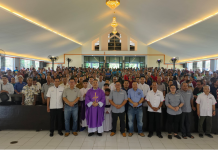
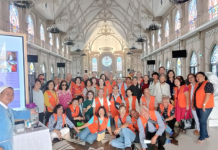
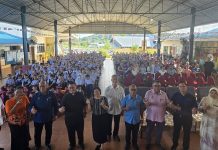

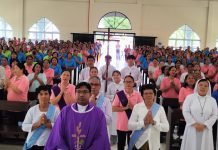
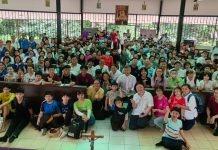

、尤金·玛格拉桑神父(Fr-Eugene-Maglasang)(前排右八)及叶祥胜神父(前排右十)于2025年1月25日在圣体堂合影。(摄影:蔡彼得).jpg)
